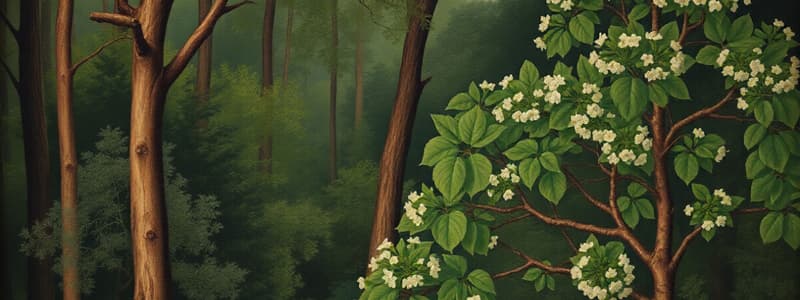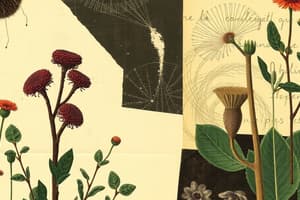Podcast
Questions and Answers
What distinguishes the point of germination between pollen grains and Selaginella male gametophyte?
What distinguishes the point of germination between pollen grains and Selaginella male gametophyte?
Pollen grains germinate from a point opposite the meiotic scars, while Selaginella male gametophyte germinates at the tetrad scars left by the other daughter microspores.
Name the four extant phyla of gymnosperms.
Name the four extant phyla of gymnosperms.
The four extant gymnosperm phyla are Coniferophyta, Cycadophyta, Gnetophyta, and Ginkgophyta.
What reproductive feature do gymnosperms share that differentiates them from angiosperms?
What reproductive feature do gymnosperms share that differentiates them from angiosperms?
Gymnosperms have seeds and lack flowers, as their ovules rest on modified leaves.
How do the male gametes differ in the Ginkgo and cycad gymnosperms compared to other gymnosperms?
How do the male gametes differ in the Ginkgo and cycad gymnosperms compared to other gymnosperms?
Explain the origin of the term 'gymnosperm'.
Explain the origin of the term 'gymnosperm'.
What are two disadvantages of non-seed plants compared to seed plants?
What are two disadvantages of non-seed plants compared to seed plants?
Explain the significance of the ovule in seed evolution.
Explain the significance of the ovule in seed evolution.
How has pollen grain evolution contributed to reproduction in seed plants?
How has pollen grain evolution contributed to reproduction in seed plants?
What role does dormancy play in the seed life cycle?
What role does dormancy play in the seed life cycle?
In what way did the evolution of seeds influence the ecology of plants?
In what way did the evolution of seeds influence the ecology of plants?
What differentiates gymnosperms from angiosperms in terms of ovule structure?
What differentiates gymnosperms from angiosperms in terms of ovule structure?
What distinguishes conifers in the Phylum Coniferophyta from other gymnosperms?
What distinguishes conifers in the Phylum Coniferophyta from other gymnosperms?
Describe two preconditions necessary for the evolution of seeds.
Describe two preconditions necessary for the evolution of seeds.
Explain the significance of resin in Pinus species.
Explain the significance of resin in Pinus species.
What does the term Spermatophyta refer to?
What does the term Spermatophyta refer to?
Describe the structure of male cones in Pinus.
Describe the structure of male cones in Pinus.
How do integuments contribute to seed structure?
How do integuments contribute to seed structure?
What happens to microspore mother cells in the male cones?
What happens to microspore mother cells in the male cones?
What is the role of the micropyle in seeds?
What is the role of the micropyle in seeds?
How do female cones differ from male cones in the Pinus life cycle?
How do female cones differ from male cones in the Pinus life cycle?
What is the function of the micropyle in the ovule?
What is the function of the micropyle in the ovule?
What evolutionary significance do the fossils of Archaeosperma hold?
What evolutionary significance do the fossils of Archaeosperma hold?
Describe the development of the female gametophyte in Pinus.
Describe the development of the female gametophyte in Pinus.
How did the male gametophyte evolve in seed plants?
How did the male gametophyte evolve in seed plants?
Why did the evolution of the seed have massive ecological implications?
Why did the evolution of the seed have massive ecological implications?
What triggers the pollen grain to move toward the nucellus during fertilization?
What triggers the pollen grain to move toward the nucellus during fertilization?
How is the diploid zygote formed in Pinus fertilization?
How is the diploid zygote formed in Pinus fertilization?
What is the difference between spermatophyte and non-spermatophyte plants in terms of reproduction?
What is the difference between spermatophyte and non-spermatophyte plants in terms of reproduction?
What are the components of a seed in Pinus?
What are the components of a seed in Pinus?
What is the relationship between macrosporangium and nucellus in seed plants?
What is the relationship between macrosporangium and nucellus in seed plants?
What is the importance of heterospory in conifers?
What is the importance of heterospory in conifers?
How do seeds from Pinus germinate after a dormancy period?
How do seeds from Pinus germinate after a dormancy period?
Why is the development of the macrosporangium significant in the life cycle of Pinus?
Why is the development of the macrosporangium significant in the life cycle of Pinus?
What adaptations do needle-shaped leaves provide for Pinus trees?
What adaptations do needle-shaped leaves provide for Pinus trees?
Flashcards
Gymnosperm Definition
Gymnosperm Definition
Gymnosperms are seed plants lacking flowers, with ovules exposed on modified leaves rather than enclosed in ovaries.
Gymnosperm Reproduction
Gymnosperm Reproduction
Gymnosperms have varying reproductive cycles, with some having motile sperm while others have immotile sperm.
Pollen Grain Germination (Point)
Pollen Grain Germination (Point)
Pollen grains germinate from a position opposite the meiotic scars on the spore wall.
Selaginella Gametophyte Germination
Selaginella Gametophyte Germination
Signup and view all the flashcards
Gymnosperm Phyla
Gymnosperm Phyla
Signup and view all the flashcards
Disadvantage of non-seed plants
Disadvantage of non-seed plants
Signup and view all the flashcards
Seed advantage
Seed advantage
Signup and view all the flashcards
Ovule
Ovule
Signup and view all the flashcards
Pollen grain
Pollen grain
Signup and view all the flashcards
Spermatophyta
Spermatophyta
Signup and view all the flashcards
Gymnosperms
Gymnosperms
Signup and view all the flashcards
Angiosperms
Angiosperms
Signup and view all the flashcards
Seed evolution time
Seed evolution time
Signup and view all the flashcards
Seed's protective layer
Seed's protective layer
Signup and view all the flashcards
Nucellus
Nucellus
Signup and view all the flashcards
Micropyle
Micropyle
Signup and view all the flashcards
Seed dormancy
Seed dormancy
Signup and view all the flashcards
Seed's ecological value
Seed's ecological value
Signup and view all the flashcards
Homospory to heterospory
Homospory to heterospory
Signup and view all the flashcards
Pollen's evolution
Pollen's evolution
Signup and view all the flashcards
Coniferophyta (conifers)
Coniferophyta (conifers)
Signup and view all the flashcards
Pinus
Pinus
Signup and view all the flashcards
Heterosporous
Heterosporous
Signup and view all the flashcards
Male cone (microstrobili)
Male cone (microstrobili)
Signup and view all the flashcards
Female cone (macrostrobili)
Female cone (macrostrobili)
Signup and view all the flashcards
Megaspore
Megaspore
Signup and view all the flashcards
Archegonia
Archegonia
Signup and view all the flashcards
Seed
Seed
Signup and view all the flashcards
Pollination
Pollination
Signup and view all the flashcards
Embryo
Embryo
Signup and view all the flashcards
Wind dispersal
Wind dispersal
Signup and view all the flashcards
Study Notes
Gymnosperms and Seed Evolution - Conifers
- Gymnosperms evolved from free-sporing progymnosperms about 425 million years ago.
- Seed evolution had significant ecological impacts.
- A sporophyte tissue layer protects the developing embryo.
- Nucellus is the macrosporangium of the seed plant, surrounded by integuments.
- Integuments harden into the seed coat.
Non-Seed Plant Life Cycle Disadvantages
- Water is still necessary for male gametes to reach female gametes.
- New sporophyte is temporarily dependent on small gametophyte plants (zygote and embryo).
- Many sporophytes die.
Advantages of Seed Plants
- Embryo utilizes pre-existing sporophyte photosynthetic and absorptive capabilities (leaves and roots).
- Female gametophyte (embryo sac) and embryo can remain within the maternal sporophyte, made possible by retention of the macrospore within the macrosporangium.
Transfer of Male Gametophyte
- The whole male gametophyte is now transferred to the female gametophyte (not just the male gametes).
- Vectors like wind carry mature microspore products (pollen grains) to female gametophytes.
- Pollen grain germinates on the maternal sporophyte.
- Male gametophyte develops within the microspore wall, becoming the pollen grain wall.
- Spermatophyta is the formal name for all plants that produce seeds.
Seed Plant Adaptations
- Seeds enclose the embryo in protective seed tissue, allowing for dormancy.
- Dormancy ensures the embryo can survive until favorable conditions for germination arise.
- This leads to optimal germination and seedling development.
Gymnosperm Classification
- Spermatophyta:
- Gymnospermae: ovules are exposed to the atmosphere
- Angiospermae (Anthophyta): ovules are enclosed within the sporophyte tissue.
- Although gymnosperm phyla exhibit morphological variation, their life cycles, gametophyte structures, and fertilization processes are relatively similar.
Early Seeds
- Early seeds of the late Paleozoic era (400-250 million years ago) typically occurred terminally on the stem axis, exhibiting bilateral or radial symmetry.
- Archaeosperma is one of the oldest plants with well-developed seed structures.
- Archaeosperma lived in the late Devonian (360 million years ago).
- Archaeosperma is interpreted as a group of loosely arranged, radially symmetric seeds.
- Every seed has a macrosporangium (nucellus) surrounded by a protective integumentary layer with finger-like outgrowths.
- Later Carboniferous fossils show typical seed structures, with progressively more deeply enclosed macrosporangia within integuments.
Pollen - Male Version of a Seed
- Pollen is the male version of a seed.
- Immature male gametophyte inside the microspore wall.
- Evolved through the progressive reduction of the male gametophyte and gradual inclusion within the spore wall.
- This evolution happened independently in Selaginella.
Selaginella and Pollen Grains
- Selaginella male gametophytes germinate from tetrad scars.
- In contrast, true pollen grains emerge from a point opposite meiotic scars.
- In seed plants, these scars are absent, likely through evolutionary time.
Extant Gymnosperm Phyla
- Four extant gymnosperm phyla: Coniferophyta, Cycadophyta, Gnetophyta, and Ginkgophyta.
- Two extinct phyla: Progymnospermatophyta and Pteridospermatophyta
- Relationships between gymnosperm phyla remain somewhat contentious but gymnosperms are generally considered to be monophyletic.
Coniferophyta (Conifers)
- Most well-known gymnosperms, including pines, cedars, cypresses, and sequoias.
- Among the oldest and tallest living things, found in cold, temperate, and arid habitats worldwide.
- Commercially valuable resources like wood, paper, resin, turpentine, and taxol.
Pinus (Pine Tree)
- More than 100 species, confined to the Northern Hemisphere.
- Needle-shaped leaves in groups of 2-5 on short branches.
- Leaves adapted to minimize water loss (thick cuticle, sunken stomata).
- Contain resin ducts for protection against freezing and insects/fungi.
- Commercially important sources of turpentine and resin.
Pinus Life Cycle - Male
- Heterosporous, developing spores into two types of gametophytes.
- Pollen grains form in microsporangia of male cones (microstrobili).
- Male cones borne in groups on lower branches.
- Papery bracts (microsporophylls) spirally arranged.
- 2 microsporangia below the bract.
Pinus Life Cycle - Female
- Female cones (macrostrobili) larger than male cones, with bracts that become woody.
- 2 ovules develop on the top of each macrosporophyll.
- Each ovule has a macrosporangium (nucellus).
- Nucellus surrounded by integumentary layer.
- Tiny opening in integument (micropyle).
- Integument hardens into seed coat.
Pinus Life Cycle - Fertilization
- Pollen grain carried by wind lands in sticky pollination droplet on micropyle.
- Pollen tube germinates and grows to the archegonium.
- Zygote develops within the seed, into an embryo.
- Seeds released after dormancy.
- Seeds germinate to form new sporophyte generation.
- One sperm fuses with the egg to form a zygote, creating the embryo.
- The other parts of the male gametophyte disintegrate.
Studying That Suits You
Use AI to generate personalized quizzes and flashcards to suit your learning preferences.




